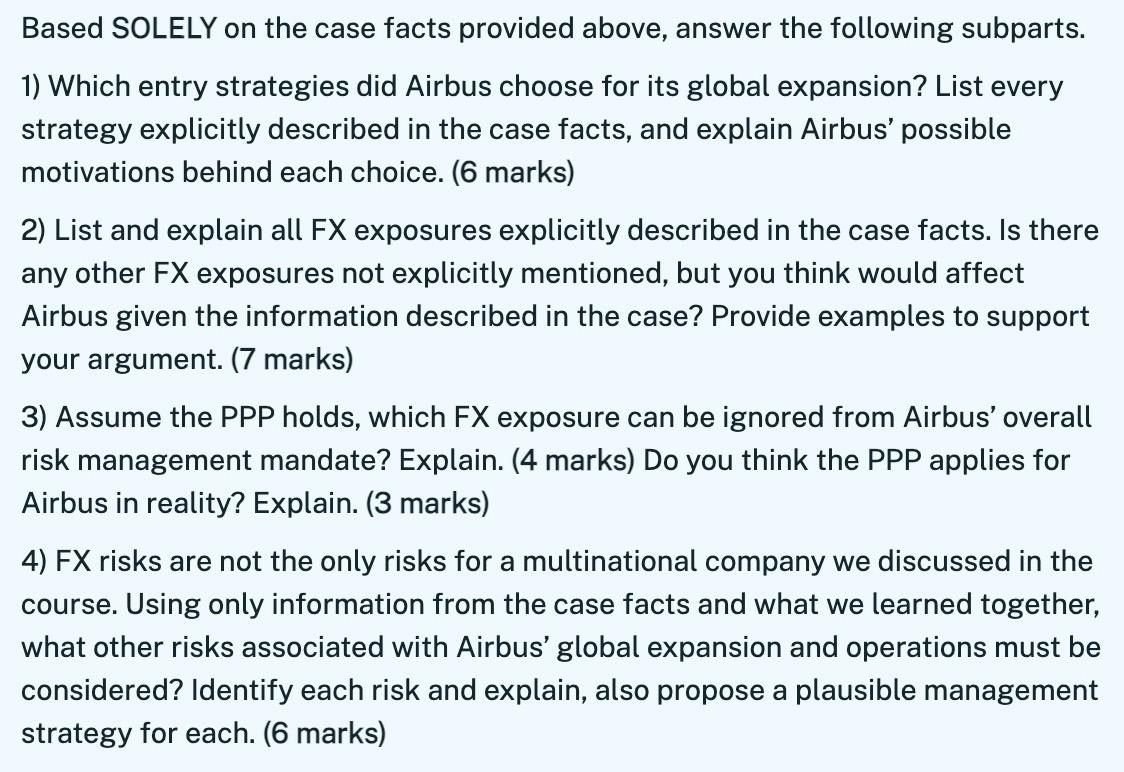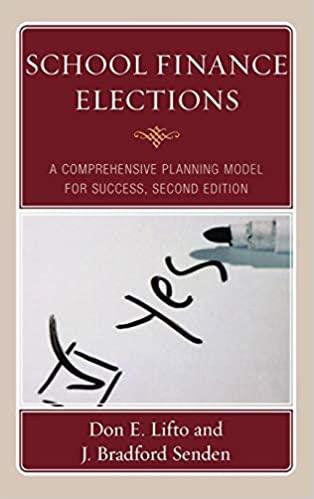

Based SOLELY on the case facts provided above, answer the following subparts. 1) Which entry strategies did Airbus choose for its global expansion? List every strategy explicitly described in the case facts, and explain Airbus' possible motivations behind each choice. (6 marks) 2) List and explain all FX exposures explicitly described in the case facts. Is there any other FX exposures not explicitly mentioned, but you think would affect Airbus given the information described in the case? Provide examples to support your argument. (7 marks) 3) Assume the PPP holds, which FX exposure can be ignored from Airbus' overall risk management mandate? Explain. (4 marks) Do you think the PPP applies for Airbus in reality? Explain. (3 marks) 4) FX risks are not the only risks for a multinational company we discussed in the course. Using only information from the case facts and what we learned together, what other risks associated with Airbus' global expansion and operations must be considered? Identify each risk and explain, also propose a plausible management strategy for each. (6 marks) Airbus is a French multinational aerospace corporation. It has operations in 180 locations worldwide, serving markets in Europe, the Americas, Africa & the Middle East, and Asia. For example, Airbus has a subsidiary in Finland that hires nearly 400 highly-skilled employees for research and development, engineering, and project management. In 2008, Airbus opened a final assembly line (FAL) in Tianjin, China, which is Airbus' first non-European FAL and it is a joint venture between Airbus and a consortium of Tianjin Free Trade Zone and China Aviation Industry Corporation. By 2018, nearly a quarter of Airbus' jetliners are sold to China, with many of those assembled in Tianjin. Airbus faced lower demand since the pandemic. Airbus has suspended support services to Russia after the Ukraine war. It is however urging the EU against blocking titanium imports from Russia, which is used widely in aircraft construction. These risk factors are common for the entire aviation industry, including Boeing, Airbus' major competitor based in the United States. Airbus' functional currency is the euro, while Boeing's is the USD. Most sales involving aircrafts are denominated in USD. Over 70% of Airbus' revenues are in USD, around 60% of this exposure are naturally hedged against costs in USD; Airbus' remaining costs are mainly in euros. Most of Boeing's revenues and costs are in USD. In 2022, the euro has weakened over worries about economic weakness in Europe, while the USD is rising in strength against most major currencies. Since 2022, Air India is in talks with both Airbus and Boeing about potential orders to replace the airline's aging fleet. Air India was one of the world's first buyers of the Boeing 787 Dreamliner. The airline also owns a fleet of Airbus A320 jets. The deal is expected to be worth USD13 billion for the selected manufacturer. It usually takes at least one year for such deals to be decided. Based SOLELY on the case facts provided above, answer the following subparts. 1) Which entry strategies did Airbus choose for its global expansion? List every strategy explicitly described in the case facts, and explain Airbus' possible motivations behind each choice. (6 marks) 2) List and explain all FX exposures explicitly described in the case facts. Is there any other FX exposures not explicitly mentioned, but you think would affect Airbus given the information described in the case? Provide examples to support your argument. (7 marks) 3) Assume the PPP holds, which FX exposure can be ignored from Airbus' overall risk management mandate? Explain. (4 marks) Do you think the PPP applies for Airbus in reality? Explain. (3 marks) 4) FX risks are not the only risks for a multinational company we discussed in the course. Using only information from the case facts and what we learned together, what other risks associated with Airbus' global expansion and operations must be considered? Identify each risk and explain, also propose a plausible management strategy for each. (6 marks) Airbus is a French multinational aerospace corporation. It has operations in 180 locations worldwide, serving markets in Europe, the Americas, Africa & the Middle East, and Asia. For example, Airbus has a subsidiary in Finland that hires nearly 400 highly-skilled employees for research and development, engineering, and project management. In 2008, Airbus opened a final assembly line (FAL) in Tianjin, China, which is Airbus' first non-European FAL and it is a joint venture between Airbus and a consortium of Tianjin Free Trade Zone and China Aviation Industry Corporation. By 2018, nearly a quarter of Airbus' jetliners are sold to China, with many of those assembled in Tianjin. Airbus faced lower demand since the pandemic. Airbus has suspended support services to Russia after the Ukraine war. It is however urging the EU against blocking titanium imports from Russia, which is used widely in aircraft construction. These risk factors are common for the entire aviation industry, including Boeing, Airbus' major competitor based in the United States. Airbus' functional currency is the euro, while Boeing's is the USD. Most sales involving aircrafts are denominated in USD. Over 70% of Airbus' revenues are in USD, around 60% of this exposure are naturally hedged against costs in USD; Airbus' remaining costs are mainly in euros. Most of Boeing's revenues and costs are in USD. In 2022, the euro has weakened over worries about economic weakness in Europe, while the USD is rising in strength against most major currencies. Since 2022, Air India is in talks with both Airbus and Boeing about potential orders to replace the airline's aging fleet. Air India was one of the world's first buyers of the Boeing 787 Dreamliner. The airline also owns a fleet of Airbus A320 jets. The deal is expected to be worth USD13 billion for the selected manufacturer. It usually takes at least one year for such deals to be decided








